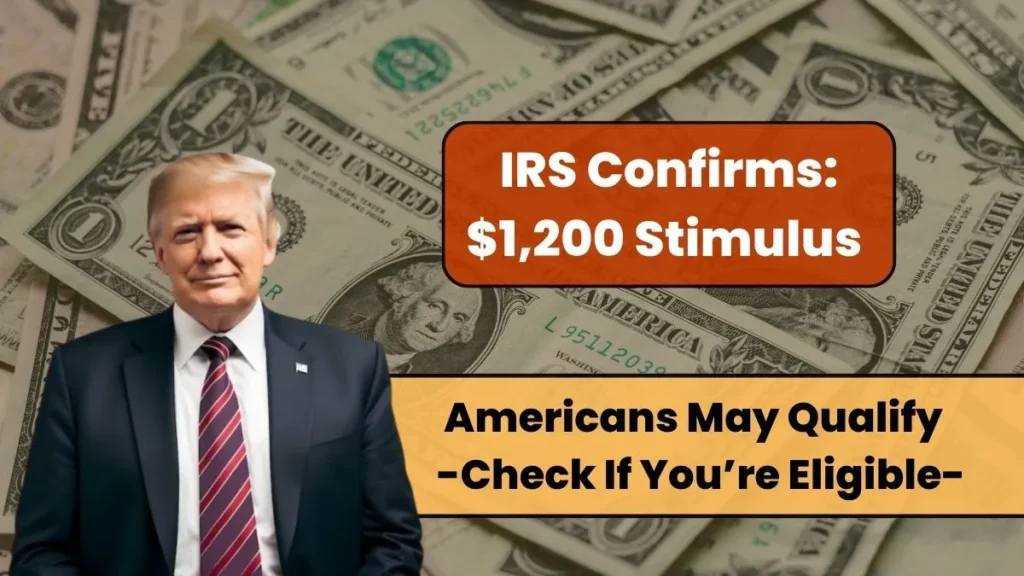The talk of an extra $1,200 stimulus has captured attention once again across the United States. While the federal government has not rolled out a new nationwide stimulus package, the IRS plays a key role in ensuring Americans claim what they are entitled to.
Through tax credits, rebates, and catch-up claims for missed Economic Impact Payments, some households may still see extra relief in 2025. This article explores who may qualify, how to check eligibility, and the smartest ways to claim every dollar owed. If you have been wondering whether the IRS has something extra for you this year, here’s the full breakdown.

Why the IRS Still Matters for Stimulus
Even though the large-scale COVID-19 stimulus checks are over, the IRS remains the agency through which refunds, rebates, and credits are distributed. Many Americans who missed payments or filed late can still recover money through the Recovery Rebate Credit.
In addition, other relief measures—like the Child Tax Credit (CTC), the Earned Income Tax Credit (EITC), and state-level rebate programs—provide cash support that feels very much like a stimulus. By reviewing your tax return and ensuring it is up to date, you may still unlock an extra $1,200 stimulus-style benefit depending on your situation.
Who May Qualify for the Extra $1,200 Stimulus in 2025
Eligibility varies depending on income, family status, and past filings. Here are the main categories:
- Late Filers: If you missed earlier stimulus checks, you may still claim them through the IRS Recovery Rebate Credit.
- Parents: The Child Tax Credit continues to provide significant relief, with eligible households receiving thousands in refunds.
- Low-to-Moderate Income Workers: The EITC offers a refundable benefit worth hundreds or more.
- Social Security & SSI Recipients: Some benefits are automatically adjusted, and past missed stimulus payments can still be claimed.
- State-Level Rebates: Several states still issue one-time rebates in 2025.
IRS Tools to Check Eligibility
The IRS provides multiple online tools to help taxpayers confirm their eligibility:
| Tool | Purpose | Where to Find It |
|---|---|---|
| Where’s My Refund? | Track refund status | IRS.gov/refunds |
| Get Transcript Online | View past returns and credits | IRS.gov/transcripts |
| Interactive Tax Assistant | Check credit eligibility | IRS.gov/ita |
Using these tools ensures you don’t miss out on credits or refunds that act as extra $1,200 stimulus-style payments.
Secondary Relief Programs That Feel Like a Stimulus
Even if you don’t qualify for direct stimulus, other IRS-supported programs can add up:
- Recovery Rebate Credit – Claim missed stimulus checks from 2020–2021.
- Child Tax Credit (CTC) – Worth up to $2,000 per child, partially refundable.
- Earned Income Tax Credit (EITC) – Provides extra support for working families.
- State Rebates – States like California, Colorado, and Maine issue one-time rebates.
- Energy & Education Credits – Credits for green energy and tuition savings.
Combined, these can deliver thousands—making the extra $1,200 stimulus realistic for many households.
Key Deadlines to Watch in 2025
Missing deadlines is one of the most common reasons Americans lose stimulus-related money.
- April 15, 2025: Deadline to claim Recovery Rebate Credit for the 2021 tax year.
- Ongoing in 2025: State rebate checks distributed throughout the year.
- Tax Filing Season 2026: Last chance to retroactively claim credits.
Action step: If you haven’t filed or claimed, make sure to act before these dates.
How to Claim the Extra $1,200 Stimulus Safely
To avoid scams and ensure you get legitimate money:
- Always file directly with IRS.gov or an authorized e-filing service.
- Never pay “stimulus processors” or click suspicious links.
- Keep copies of past returns and IRS letters.
- Use IRS Free File if your income is below $79,000.
By filing accurately and on time, you maximize your chances of receiving every possible benefit—including the extra $1,200 stimulus if you qualify.
Conclusion
While there is no brand-new federal program issuing an extra $1,200 stimulus to all Americans in 2025, the IRS remains central in ensuring taxpayers get the money they are owed. Between the Recovery Rebate Credit, Child Tax Credit, EITC, and ongoing state rebates, many households can still see significant cash relief this year.
The key is to act before deadlines, use official IRS tools, and claim every credit available. If you’ve been wondering whether you qualify, the time to check is now—the IRS may confirm you’re still eligible for thousands, including what feels like an extra $1,200 stimulus.